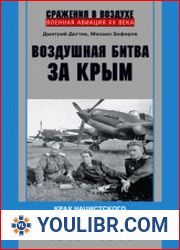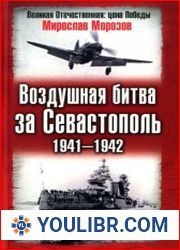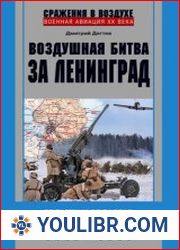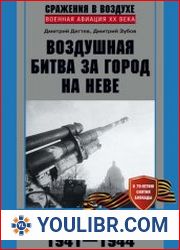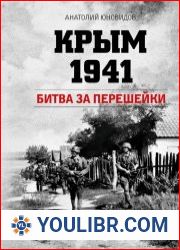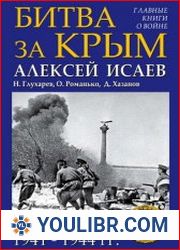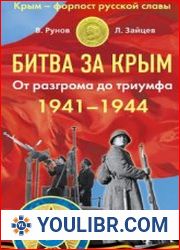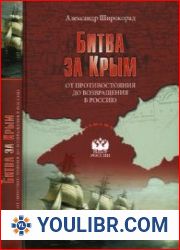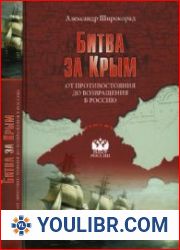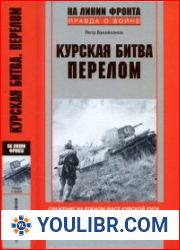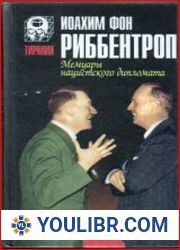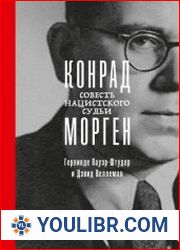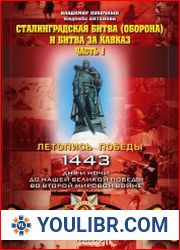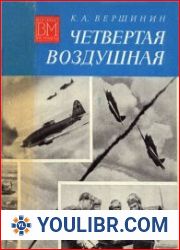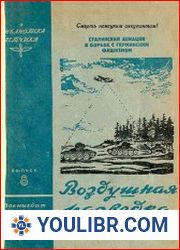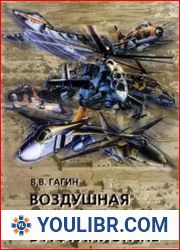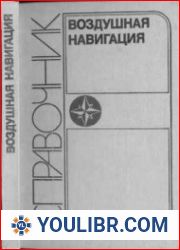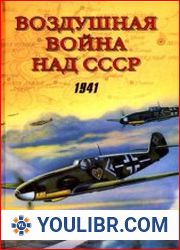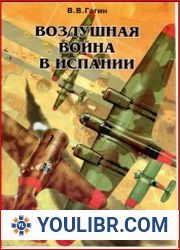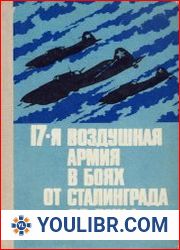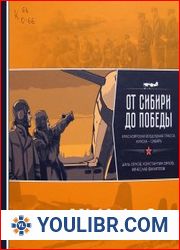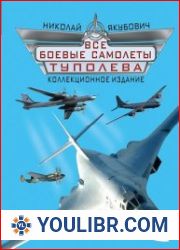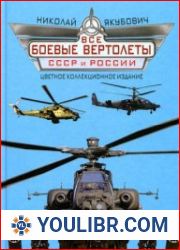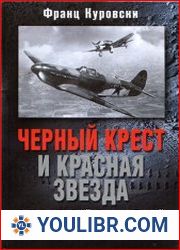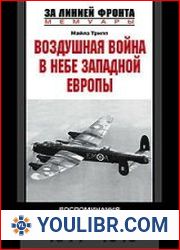
BOOKS - MILITARY HISTORY - Воздушная битва за Крым. Крах нацистского «Готенланда». 19...

Воздушная битва за Крым. Крах нацистского «Готенланда». 1943—1944
Author: Михаил Зефиров, Дмитрий Дёгтев
Year: 2022
Format: PDF | RTF
File size: 10 MB
Language: RU
Year: 2022
Format: PDF | RTF
File size: 10 MB
Language: RU
The battle for Crimea, which lasted intermittently for two and a half years, stands apart in the history of World War II. Both warring parties, or rather their leaders - Adolf Hitler and Joseph Stalin - attached extremely important importance to the possession of this peninsula. The first fanatically tried to keep him, even when the Eastern Front was literally bursting at the seams, and its southern flank rolled back far to the west, the second attached the highest priority to the liberation of Crimea. As a result, the liberation of the "all-Union health resort" lasted for six months and turned into a protracted grueling battle, in which large forces of the ground forces and fleets of both sides were drawn in. And in the sky, one of the longest and most fierce air battles broke out, which was not interrupted either during the day, or at night, or in bad weather. The Crimean epic ended with an incredible finale in drama and intensity of events: the rapid throw of the Red Army to Sevastopol and the desperate attempt of the enemy to take their troops to Romania. This book, based on domestic and German archival documents and other sources, for the first time tells about the air battle for the Crimea, which lasted from November 1, 1943 to May 12, 1944, in which many famous Soviet and German aces participated.
The Battle for Crimea: A Technological Evolution and Personal Paradigm for Survival Capitalizing on the importance of technological evolution and personal paradigms, this article delves into the air battle for Crimea during World War II, providing a detailed description of the plot of the book "Воздушная битва за Крым Крах нацистского «Готенланда» 1943—1944". The battle, which lasted intermittently for two and a half years, was a pivotal moment in history, as both Adolf Hitler and Joseph Stalin attached extreme significance to the possession of the peninsula. The Battle's Progression The battle began in November 1943 and continued until May 12, 1944, with the Red Army and German forces engaging in a protracted and grueling fight. The air battle was not interrupted by day or night, nor was it deterred by bad weather conditions. The epic conclusion of the battle saw the rapid throw of the Red Army into Sevastopol, while the enemy attempted to take their troops to Romania. Kampf um die Krim: Technologische Evolution und persönliches Paradigma für die Umwandlung in Überlebenskapital Von der Bedeutung der technologischen Evolution und persönlichen Paradigmen gräbt sich dieser Artikel in die Luftschlacht für die Krim während des Zweiten Weltkriegs und bietet eine detaillierte Beschreibung der Handlung des Buches "Luftschlacht um die Krim" Der Zusammenbruch des Nazi "Gotenland" 1943-1944 ". Die Schlacht, die mit Unterbrechungen zweieinhalb Jahre dauerte, war ein Wendepunkt in der Geschichte, da sowohl Adolf Hitler als auch Josef Stalin dem Besitz der Halbinsel außerordentliche Bedeutung beimessen. Der Vormarsch der Schlacht Die Schlacht begann im November 1943 und dauerte bis zum 12. Mai 1944, als die Rote Armee und die deutschen Truppen in einen langwierigen und zermürbenden Kampf eintraten. Der Luftkampf wurde weder Tag noch Nacht unterbrochen, noch durch schlechte Wetterbedingungen zurückgehalten. Das epische Ende der Schlacht war durch den schnellen Wurf der Roten Armee nach Sewastopol gekennzeichnet, während der Feind versuchte, seine Truppen nach Rumänien abzuziehen. クリミアの戦い:技術的進化と個人的なパラダイム技術的進化と個人的なパラダイムの重要性から、この記事は、第二次世界大戦中のクリミアのための空戦に掘り下げ、本のプロットの詳細な説明を提供します"ナチのクリミアの戦いの崩壊Gotenland 1943-1944。2半にわたって断続的に続いたこの戦いは、アドルフ・ヒトラーとヨーゼフ・スターリンの両方が半島の所有を極めて重要視していたため、歴史の転換点となった。戦闘の前進この戦闘は194311月に始まり、19445月12日まで続いた。この戦闘は昼夜を問わず中断されず、悪天候にも抑えられなかった。戦いの壮大な結論は、赤軍がセヴァストポリに急速に投げられたことによって特徴付けられ、敵はルーマニアに軍を撤退させようとした。 Batalla de Crimea: Evolución Tecnológica y Paradigma Personal para la Transformación en Capital Supervivencia a partir de la importancia de la evolución tecnológica y los paradigmas personales, este artículo profundiza en la batalla aérea para Crimea durante la Segunda Guerra Mundial, proporcionando una descripción detallada de la trama del libro "La batalla aérea de Crimea colapso del" Gotenland "nazi" 1943 - 1944 ". La batalla, que duró dos y medio de manera intermitente, marcó un punto de inflexión en la historia, ya que tanto Adolf Hitler como Iósif Stalin dieron una importancia extraordinaria a la posesión de la península. avance de la batalla La batalla comenzó en noviembre de 1943 y continuó hasta el 12 de mayo de 1944, cuando el Ejército Rojo y las fuerzas alemanas entraron en una prolongada y agotadora lucha. combate aéreo no se interrumpió ni por la tarde ni por la noche, tampoco se vio contenido por las malas condiciones meteorológicas. La épica conclusión de la batalla estuvo marcada por el rápido lanzamiento del Ejército Rojo a Sebastopol, mientras que el enemigo intentó retirar sus tropas a Rumanía. Batalha pela Crimeia: Evolução tecnológica e Paradigma Pessoal para se transformar em capital de sobrevivência a partir da importância da evolução tecnológica e dos paradigmas pessoais, este artigo é escavado na batalha aérea para a Crimeia durante a Segunda Guerra Mundial, fornecendo uma descrição detalhada da história de "A Batalha Aérea da Crimeia O Colapso Nazi de Gotenland" 1943-1944 ". A batalha, que durou dois anos e meio, representou um ponto de viragem na história, porque tanto Adolf Hitler como Joseph Estaline deram uma importância extraordinária à posse da península. O avanço da Batalha começou em Novembro de 1943 e durou até 12 de Maio de 1944, quando o Exército Vermelho e as tropas alemãs lutaram prolongadamente e exaustivamente. O combate aéreo não foi interrompido durante o dia, nem à noite, nem as más condições meteorológicas. O fim épico da batalha foi marcado por um rápido lançamento do Exército Vermelho para Sebastopol, enquanto o inimigo tentava levar suas tropas para a Roménia. 克裏米亞之戰:技術進化論和個人範式從技術進化和個人範式的重要性轉變為生存之都,本文深入研究了第二次世界大戰期間克裏米亞的空戰,詳細描述了《克裏米亞之戰》的情節納粹"哥登蘭"的崩潰1943-1944"。這場戰鬥斷斷續續地持續了兩半的時間,標誌著歷史的轉折點,因為阿道夫·希特勒和約瑟夫·斯大林都非常重視半島的擁有。戰鬥的前進始於194311月,一直持續到19445月12日,當時紅軍和德軍進行了曠日持久而艱苦的戰鬥。空戰沒有白天或晚上中斷,也沒有受到惡劣天氣條件的阻礙。戰鬥的史詩般的結束以紅軍迅速向塞瓦斯托波爾投擲為標誌,而敵人則試圖將其部隊帶到羅馬尼亞。
La bataille pour la Crimée : Évolution technologique et paradigme personnel pour devenir le capital Survie de l'importance de l'évolution technologique et paradigme personnel, cet article est creusé dans la bataille aérienne pour la Crimée pendant la Seconde Guerre mondiale, fournissant une description détaillée de l'histoire du livre "La bataille aérienne pour la Crimée crash du Gotenland nazi" 1943-1944 ". La bataille, qui a duré deux ans et demi, a marqué un tournant dans l'histoire, car Adolf Hitler et Joseph Staline ont accordé une importance extrême à la possession de la péninsule. La bataille a commencé en novembre 1943 et s'est poursuivie jusqu'au 12 mai 1944, lorsque l'Armée rouge et les troupes allemandes se sont engagées dans une lutte prolongée et épuisante. combat aérien n'a pas été interrompu ni jour ni nuit, ni freiné par les mauvaises conditions météorologiques. La fin épique de la bataille a été marquée par le lancement rapide de l'Armée rouge à Sébastopol, tandis que l'ennemi a tenté de retirer ses troupes en Roumanie. Battle of Crimea: Evolution Technological and Personal Pardigm for Backing Capital מתוך החשיבות של אבולוציה טכנולוגית ופרדיגמות אישיות, מאמר זה חופר לתוך הקרב האווירי על קרים במהלך מלחמת העולם השנייה, ומספק תיאור מפורט של עלילת הספר "קרב אוויר של קרים" 1943 - 1944 ". הקרב, שנמשך לסירוגין במשך שנתיים וחצי, היה נקודת מפנה בהיסטוריה, מאחר שגם אדולף היטלר וגם יוסיף סטלין ייחסו חשיבות רבה לחזקת חצי האי. התקדמות הקרב החלה בנובמבר 1943 ונמשכה עד 12 במאי 1944, אז נכנסו כוחות הצבא האדום וגרמנים למאבק ממושך ומפרך. קרב האוויר לא נקטע ביום או בלילה, ולא היה מאופק על ידי תנאי מזג אוויר גרועים. הסיום האפי של הקרב היה מסומן על ידי זריקת הצבא האדום לסבסטופול, בעוד האויב ניסה להסיג את כוחותיו לרומניה. Сражение за Крым: Технологическая Эволюция и Личная Парадигма для Превращения в капитал Выживания из важности технологической эволюции и личные парадигмы, эта статья копается в воздушном сражении для Крыма во время Второй мировой войны, предоставляя подробное описание сюжета книги «Воздушная битва за Крым Крах нацистского «Готенланда» 1943 - 1944». Битва, длившаяся с перерывами два с половиной года, стала поворотным моментом в истории, поскольку и Адольф Гитлер, и Иосиф Сталин придавали обладанию полуостровом чрезвычайное значение. Продвижение битвы Сражение началось в ноябре 1943 года и продолжалось до 12 мая 1944 года, когда Красная армия и немецкие войска вступили в затяжную и изнурительную борьбу. Воздушный бой не прерывался ни днем, ни ночью, не сдерживался и плохими погодными условиями. Эпическое завершение сражения ознаменовалось стремительным броском Красной Армии в Севастополь, в то время как противник предпринял попытку увести свои войска в Румынию. Kırım Savaşı: Teknolojik Evrim ve Hayatta Kalma Başkenti Olmak için Teknolojik Evrim ve Kişisel Paradigma, teknolojik evrim ve kişisel paradigmaların öneminden dolayı, bu makale II. Dünya Savaşı sırasında Kırım için hava savaşına giriyor ve "Nazi Gotenland'ın Çöküşü Kırım Hava Savaşı 1943 - 1944" kitabının arsa hakkında ayrıntılı bir açıklama sunuyor. Aralıklı olarak iki buçuk yıl süren savaş, hem Adolf Hitler hem de Joseph Stalin yarımadanın mülkiyetine son derece önem verdiği için tarihte bir dönüm noktasıydı. Muharebenin ilerlemesi Muharebe Kasım 1943'te başladı ve Kızıl Ordu ve Alman birliklerinin uzun ve yorucu bir mücadeleye girdiği 12 Mayıs 1944'e kadar sürdü. Hava savaşı gece ya da gündüz kesintiye uğramadı ve kötü hava koşullarından etkilenmedi. Savaşın destansı sonucu, Kızıl Ordu'nun vastopol'a hızlı bir şekilde atılmasıyla belirginleşirken, düşman birliklerini Romanya'ya çekmeye çalıştı. 크림의 전투: 기술 진화와 개인 패러다임의 중요성에서 생존 자본이되기위한 기술 진화와 개인 패러다임은 제 2 차 세계 대전 중 크림의 공중전을 파헤쳐 서 "나치 고텐 란드의 크림 붕괴의 공기 전투 1943-1944". 아돌프 히틀러와 조셉 스탈린이 한반도 소유에 매우 중요성을 부여했기 때문에 2 년 반 동안 간헐적으로 지속 된 전투는 역사의 전환점이었습니다. 전투의 발전은 1943 년 11 월에 시작되어 1944 년 5 월 12 일까지 붉은 군대와 독일군이 장기적이고 잔인한 투쟁을 시작했습니다. 공중전은 낮이나 밤에 중단되지 않았으며 악천후로 인해 제한되지 않았습니다. 전투의 서사시 결론은 붉은 군대가 세 바스 토폴로 빠르게 던져졌고 적군은 루마니아로 군대를 철수 시키려고 시도했다. Bitwa o Krym: Ewolucja technologiczna i paradygmat osobisty dla stania się kapitałem przetrwania z znaczenia rozwoju technologicznego i paradygmatów osobistych, ten artykuł wykopuje się do bitwy powietrznej na Krym podczas II wojny światowej, dostarczając szczegółowy opis działki książki „Bitwa powietrzna Krymu upadku Gotenland nazistowski 1943 - 1944”. Bitwa, która trwała nieprzerwanie przez dwa i pół roku, była punktem zwrotnym w historii, ponieważ zarówno Adolf Hitler, jak i Józef Stalin przywiązywali ogromną wagę do posiadania półwyspu. Bitwa rozpoczęła się w listopadzie 1943 roku i trwała do 12 maja 1944 roku, kiedy to Armia Czerwona i wojska niemieckie przystąpiły do długotrwałej i ciężkiej walki. Bitwa powietrzna nie została przerwana ani w dzień, ani w nocy i nie została powstrzymana przez złe warunki pogodowe. Epickie zakończenie bitwy było naznaczone szybkim rzutem Armii Czerwonej do Sewastopola, podczas gdy wróg próbował wycofać swoje wojska do Rumunii. Battaglia per la Crimea: Evoluzione Tecnologica e Paradigma Personale per la Sopravvivenza dal punto di vista dell'evoluzione tecnologica e dei paradigmi personali, questo articolo viene scavato nella battaglia aerea per la Crimea durante la Seconda Guerra Mondiale, fornendo una descrizione dettagliata del libro «La battaglia aerea per la Crimea Il crollo del nazista Gotenland 1943-1944». La battaglia, durata due anni e mezzo e interruzione, ha rappresentato un punto di svolta nella storia, perché sia Adolf Hitler che Joseph Stalin hanno dato una importanza straordinaria al possesso della penisola. L'avanzata della battaglia iniziò nel novembre 1943 e proseguì fino al 12 maggio 1944, quando l'Esercito Rosso e le truppe tedesche entrarono in una lotta prolungata ed estenuante. La battaglia aerea non si è interrotta né di giorno né di notte, né le cattive condizioni meteo. L'epica conclusione della battaglia è stata segnata da un rapido lancio dell'Armata Rossa a Sebastopoli, mentre l'avversario ha tentato di portare le sue truppe in Romania. معركة شبه جزيرة القرم |: التطور التكنولوجي والنموذج الشخصي لتصبح عاصمة للبقاء من أهمية التطور التكنولوجي والنماذج الشخصية، تتعمق هذه المقالة في المعركة الجوية لشبه جزيرة القرم خلال الحرب العالمية الثانية، وتقدم وصفًا مفصلاً لمؤامرة كتاب «معركة القرم الجوية انهيار النازية 1943 - 1944 جوتنلاند». كانت المعركة، التي استمرت بشكل متقطع لمدة عامين ونصف، نقطة تحول في التاريخ، حيث أولى كل من أدولف هتلر وجوزيف ستالين أهمية قصوى لامتلاك شبه الجزيرة. تقدم المعركة بدأت المعركة في نوفمبر 1943 واستمرت حتى 12 مايو 1944، عندما دخل الجيش الأحمر والقوات الألمانية في صراع طويل الأمد وشاق. لم تنقطع المعركة الجوية ليلاً أو نهارًا، ولم يتم تقييدها بسبب سوء الأحوال الجوية. تميزت النهاية الملحمية للمعركة برمي الجيش الأحمر السريع إلى سيفاستوبول، بينما حاول العدو سحب قواته إلى رومانيا. descarregar ficheiro pdf Batalha aérea pela Crimeia. O colapso do Gothenland nazi. 1943—1944 pdf 파일 다운로드 pdf dosyasını indir Kırım için hava savaşı. Nazi "Gotenland'ın çöküşü. 1943 - 1944 télécharger le fichier pdf Bataille aérienne pour la Crimée. L'effondrement du Gotenland nazi. 1943—1944 Scarica il file pdf Battaglia aerea per la Crimea. Il crollo del Gotenland nazista. 1943—1944 تنزيل ملف pdf معركة جوية لشبه جزيرة القرم. انهيار النازية «جوتنلاند». 1943 - 1944 下载 pdf 文件 克裏米亞空戰。納粹「哥騰蘭」的崩潰。1943—1944
PDF-Datei herunterladen Luftschlacht um die Krim. Der Zusammenbruch des Nazi-Gotenlandes. 1943—1944 download pdf file pobierz plik pdf download pdf file Воздушная битва за Крым. Крах нацистского «Готенланда». 1943—1944 להוריד קובץ PDF PDFファイルをダウンロード descargar archivo pdf Batalla aérea por Crimea. colapso del «Gotenland» nazi. 1943—1944 скачать файл PDF Воздушная битва за Крым. Крах нацистского »Готенланда». 1943—1944
La battaglia per la Crimea, in pausa da due anni e mezzo, è una villa nella storia della seconda guerra mondiale. Entrambe le parti in guerra, più precisamente i loro leader, Adolf Hitler e Joseph Stalin, hanno attribuito estrema importanza al possesso della penisola. Il primo ha cercato fanaticamente di trattenerlo, anche quando il fronte orientale si è letteralmente spezzato e il suo fianco meridionale si è diradato a ovest, il secondo ha dato la massima priorità alla liberazione della Crimea. Di conseguenza, la liberazione della «salute onnipresente» si è estesa di sei mesi e si è trasformata in una lunga e estenuante battaglia che ha coinvolto grandi forze delle forze di terra e delle flotte di entrambe le parti. E in cielo si giocò una delle più lunghe e violente battaglie aeree, che non si interrompeva né di giorno, né di notte, né di maltempo. L'epopea della Crimea si è conclusa con un finale incredibile per drammaticità e intensità di eventi: Questo libro, basato su documenti di archiviazione nazionali e tedeschi e su altre fonti, racconta per la prima volta la battaglia aerea per la Crimea, che durò dal 1 novembre del 1943 fino al 12 maggio del 1944.
The battle for Crimea, which lasted intermittently for two and a half years, stands apart in the history of World War II. Both warring parties, or rather their leaders - Adolf Hitler and Joseph Stalin - attached extremely important importance to the possession of this peninsula. The first fanatically tried to keep him, even when the Eastern Front was literally bursting at the seams, and its southern flank rolled back far to the west, the second attached the highest priority to the liberation of Crimea. As a result, the liberation of the "all-Union health resort" lasted for six months and turned into a protracted grueling battle, in which large forces of the ground forces and fleets of both sides were drawn in. And in the sky, one of the longest and most fierce air battles broke out, which was not interrupted either during the day, or at night, or in bad weather. The Crimean epic ended with an incredible finale in drama and intensity of events: the rapid throw of the Red Army to Sevastopol and the desperate attempt of the enemy to take their troops to Romania. This book, based on domestic and German archival documents and other sources, for the first time tells about the air battle for the Crimea, which lasted from November 1, 1943 to May 12, 1944, in which many famous Soviet and German aces participated.
La batalla de Crimea, que duró intermitentemente dos años y medio, se erige en una mansión en la historia de la Segunda Guerra Mundial. Ambas partes beligerantes, más precisamente sus líderes - Adolf Hitler y Iósif Stalin - otorgaron una importancia excepcional a la posesión de esta península. El primero trató fanáticamente de mantenerlo, incluso cuando el Frente Oriental literalmente se fracturó por las costuras, y su flanco sur retrocedió lejos hacia el oeste, el segundo le dio la máxima prioridad a la liberación de Crimea. Como resultado, la liberación del «balneario de la Unión» se extendió durante seis meses y se convirtió en una prolongada batalla agotadora en la que se vieron envueltas grandes fuerzas de las fuerzas terrestres y flotas de ambos bandos. Y en el cielo se desarrolló una de las batallas aéreas más largas y feroces, que no se interrumpió ni de día, ni de noche, ni con mal tiempo. La epopeya de Crimea concluyó con un final increíble en cuanto a dramatismo e intensidad de los acontecimientos: el rápido lanzamiento del Ejército Rojo a Sebastopol y el intento desesperado del enemigo de llevar sus tropas a Rumanía. Este libro, basado en documentos de archivo nacionales y alemanes y otras fuentes, cuenta por primera vez la batalla aérea de Crimea, que duró desde el 1 de noviembre de 1943 hasta el 12 de mayo de 1944, en la que participaron muchos conocidos ases soviéticos y alemanes.
Битва за Крым, продолжавшаяся с перерывами в течение двух с половиной лет, стоит особняком в истории Второй мировой войны. Обе воюющие стороны, точнее их лидеры – Адольф Гитлер и Иосиф Сталин – придавали исключительно важное значение обладанию этим полуостровом. Первый фанатично пытался удержать его, даже когда Восточный фронт буквально трещал по швам, а его южный фланг откатился далеко на запад, второй придавал освобождению Крыма самое приоритетное значение. В результате освобождение »всесоюзной здравницы» растянулось на полгода и превратилось в затяжную изнурительную битву, в которую были втянуты крупные силы сухопутных войск и флотов обеих сторон. А в небе разыгралось одно из самых продолжительных и ожесточенных воздушных сражений, которое не прерывалось ни днем, ни ночью, ни в плохую погоду. Крымская эпопея завершилась невероятным по драматизму и накалу событий финалом стремительным броском Красной армии к Севастополю и отчаянной попыткой противника вывезти свои войска в Румынию.В данной книге на основе отечественных и германских архивных документов и других источников впервые рассказано о воздушной битве за Крым, продолжавшейся с 1 ноября 1943 г. до 12 мая 1944 г., в которой участвовали многие известные советские и немецкие асы.
A Batalha da Crimeia, que durou dois anos e meio, é uma mansão na história da Segunda Guerra Mundial. Ambos os beligerantes, mais especificamente os seus líderes, Adolf Hitler e Joseph Stalin, atribuíram extrema importância à posse desta península. O primeiro tentou mantê-lo fanático, mesmo quando a Frente Oriental literalmente estava a quebrar as costuras, e o seu flanco sul recuou muito para oeste, o segundo deu prioridade à libertação da Crimeia. Como resultado, a libertação da «saúde pública» estendeu-se por seis meses e transformou-se numa longa e exaustiva batalha que envolveu grandes forças terrestres e flotas de ambos os lados. E houve uma das batalhas aéreas mais longas e violentas no céu, que não foi interrompida durante o dia, a noite ou o mau tempo. A epopeia da Crimeia terminou com um final incrível por dramatismo e pela imensidão dos acontecimentos: Um rápido lançamento do Exército Vermelho para Sebastopol e a tentativa desesperada do inimigo de levar suas tropas para a Romênia. Este livro, baseado em documentos de arquivo nacionais e alemães e outras fontes, descreve pela primeira vez a batalha aérea pela Crimeia, que durou de 1 de novembro de 1943 até 12 de maio de 1944, que envolveu muitas asas soviéticas e alemãs conhecidas.
Die Schlacht um die Krim, die mit Unterbrechungen zweieinhalb Jahre dauerte, steht allein in der Geschichte des Zweiten Weltkriegs. Beide Kriegsparteien, genauer gesagt ihre Führer - Adolf Hitler und Joseph Stalin - legten großen Wert auf den Besitz dieser Halbinsel. Der erste versuchte fanatisch, ihn zu halten, selbst als die Ostfront buchstäblich aus allen Nähten platzte und seine Südflanke weit nach Westen zurückfiel, der zweite gab der Befreiung der Krim die höchste Priorität. Infolgedessen erstreckte sich die Befreiung des „All-Union-Kurortes“ über sechs Monate und verwandelte sich in eine langwierige zermürbende Schlacht, in die große Kräfte der Bodentruppen und Flotten beider Seiten einbezogen wurden. Und am Himmel spielte sich eine der längsten und heftigsten Luftschlachten ab, die weder Tag noch Nacht noch bei schlechtem Wetter unterbrochen wurde. Das Krim-Epos endete in Dramatik und Intensität der Ereignisse mit einem unglaublichen Finale: In diesem Buch wird auf der Grundlage einheimischer und deutscher Archivdokumente und anderer Quellen erstmals von der Luftschlacht um die Krim erzählt, die vom 1. November 1943 bis zum 12. Mai 1944 dauerte und an der viele bekannte sowjetische und deutsche Asse teilnahmen.
La bataille de Crimée, qui a duré deux ans et demi, est un manoir de l'histoire de la Seconde Guerre mondiale. Les deux belligérants, plus précisément leurs dirigeants, Adolf Hitler et Joseph Staline, attachaient une importance capitale à la possession de cette péninsule. Le premier a essayé fanatiquement de le retenir, même lorsque le Front de l'Est s'est littéralement fissuré sur les points de suture et que son flanc sud s'est effondré loin à l'ouest, le second a donné la priorité à la libération de la Crimée. En conséquence, la libération de la « santé omniprésente » a duré six mois et s'est transformée en une longue bataille épuisante dans laquelle de grandes forces terrestres et des flottes des deux côtés ont été impliquées. Et l'une des batailles aériennes les plus longues et les plus violentes a eu lieu dans le ciel, qui n'a pas été interrompue ni de jour, ni de nuit, ni par mauvais temps. L'épopée de Crimée s'est achevée par une finale incroyable sur le dramatisme et l'intensité des événements : Ce livre, basé sur des documents d'archives nationales et allemandes et d'autres sources, décrit pour la première fois la bataille aérienne pour la Crimée, qui a duré du 1er novembre 1943 au 12 mai 1944, à laquelle ont participé de nombreux ass soviétiques et allemands.
La battaglia per la Crimea, in pausa da due anni e mezzo, è una villa nella storia della seconda guerra mondiale. Entrambe le parti in guerra, più precisamente i loro leader, Adolf Hitler e Joseph Stalin, hanno attribuito estrema importanza al possesso della penisola. Il primo ha cercato fanaticamente di trattenerlo, anche quando il fronte orientale si è letteralmente spezzato e il suo fianco meridionale si è diradato a ovest, il secondo ha dato la massima priorità alla liberazione della Crimea. Di conseguenza, la liberazione della «salute onnipresente» si è estesa di sei mesi e si è trasformata in una lunga e estenuante battaglia che ha coinvolto grandi forze delle forze di terra e delle flotte di entrambe le parti. E in cielo si giocò una delle più lunghe e violente battaglie aeree, che non si interrompeva né di giorno, né di notte, né di maltempo. L'epopea della Crimea si è conclusa con un finale incredibile per drammaticità e intensità di eventi: Questo libro, basato su documenti di archiviazione nazionali e tedeschi e su altre fonti, racconta per la prima volta la battaglia aerea per la Crimea, che durò dal 1 novembre del 1943 fino al 12 maggio del 1944.
The battle for Crimea, which lasted intermittently for two and a half years, stands apart in the history of World War II. Both warring parties, or rather their leaders - Adolf Hitler and Joseph Stalin - attached extremely important importance to the possession of this peninsula. The first fanatically tried to keep him, even when the Eastern Front was literally bursting at the seams, and its southern flank rolled back far to the west, the second attached the highest priority to the liberation of Crimea. As a result, the liberation of the "all-Union health resort" lasted for six months and turned into a protracted grueling battle, in which large forces of the ground forces and fleets of both sides were drawn in. And in the sky, one of the longest and most fierce air battles broke out, which was not interrupted either during the day, or at night, or in bad weather. The Crimean epic ended with an incredible finale in drama and intensity of events: the rapid throw of the Red Army to Sevastopol and the desperate attempt of the enemy to take their troops to Romania. This book, based on domestic and German archival documents and other sources, for the first time tells about the air battle for the Crimea, which lasted from November 1, 1943 to May 12, 1944, in which many famous Soviet and German aces participated.
La batalla de Crimea, que duró intermitentemente dos años y medio, se erige en una mansión en la historia de la Segunda Guerra Mundial. Ambas partes beligerantes, más precisamente sus líderes - Adolf Hitler y Iósif Stalin - otorgaron una importancia excepcional a la posesión de esta península. El primero trató fanáticamente de mantenerlo, incluso cuando el Frente Oriental literalmente se fracturó por las costuras, y su flanco sur retrocedió lejos hacia el oeste, el segundo le dio la máxima prioridad a la liberación de Crimea. Como resultado, la liberación del «balneario de la Unión» se extendió durante seis meses y se convirtió en una prolongada batalla agotadora en la que se vieron envueltas grandes fuerzas de las fuerzas terrestres y flotas de ambos bandos. Y en el cielo se desarrolló una de las batallas aéreas más largas y feroces, que no se interrumpió ni de día, ni de noche, ni con mal tiempo. La epopeya de Crimea concluyó con un final increíble en cuanto a dramatismo e intensidad de los acontecimientos: el rápido lanzamiento del Ejército Rojo a Sebastopol y el intento desesperado del enemigo de llevar sus tropas a Rumanía. Este libro, basado en documentos de archivo nacionales y alemanes y otras fuentes, cuenta por primera vez la batalla aérea de Crimea, que duró desde el 1 de noviembre de 1943 hasta el 12 de mayo de 1944, en la que participaron muchos conocidos ases soviéticos y alemanes.
Битва за Крым, продолжавшаяся с перерывами в течение двух с половиной лет, стоит особняком в истории Второй мировой войны. Обе воюющие стороны, точнее их лидеры – Адольф Гитлер и Иосиф Сталин – придавали исключительно важное значение обладанию этим полуостровом. Первый фанатично пытался удержать его, даже когда Восточный фронт буквально трещал по швам, а его южный фланг откатился далеко на запад, второй придавал освобождению Крыма самое приоритетное значение. В результате освобождение »всесоюзной здравницы» растянулось на полгода и превратилось в затяжную изнурительную битву, в которую были втянуты крупные силы сухопутных войск и флотов обеих сторон. А в небе разыгралось одно из самых продолжительных и ожесточенных воздушных сражений, которое не прерывалось ни днем, ни ночью, ни в плохую погоду. Крымская эпопея завершилась невероятным по драматизму и накалу событий финалом стремительным броском Красной армии к Севастополю и отчаянной попыткой противника вывезти свои войска в Румынию.В данной книге на основе отечественных и германских архивных документов и других источников впервые рассказано о воздушной битве за Крым, продолжавшейся с 1 ноября 1943 г. до 12 мая 1944 г., в которой участвовали многие известные советские и немецкие асы.
A Batalha da Crimeia, que durou dois anos e meio, é uma mansão na história da Segunda Guerra Mundial. Ambos os beligerantes, mais especificamente os seus líderes, Adolf Hitler e Joseph Stalin, atribuíram extrema importância à posse desta península. O primeiro tentou mantê-lo fanático, mesmo quando a Frente Oriental literalmente estava a quebrar as costuras, e o seu flanco sul recuou muito para oeste, o segundo deu prioridade à libertação da Crimeia. Como resultado, a libertação da «saúde pública» estendeu-se por seis meses e transformou-se numa longa e exaustiva batalha que envolveu grandes forças terrestres e flotas de ambos os lados. E houve uma das batalhas aéreas mais longas e violentas no céu, que não foi interrompida durante o dia, a noite ou o mau tempo. A epopeia da Crimeia terminou com um final incrível por dramatismo e pela imensidão dos acontecimentos: Um rápido lançamento do Exército Vermelho para Sebastopol e a tentativa desesperada do inimigo de levar suas tropas para a Romênia. Este livro, baseado em documentos de arquivo nacionais e alemães e outras fontes, descreve pela primeira vez a batalha aérea pela Crimeia, que durou de 1 de novembro de 1943 até 12 de maio de 1944, que envolveu muitas asas soviéticas e alemãs conhecidas.
Die Schlacht um die Krim, die mit Unterbrechungen zweieinhalb Jahre dauerte, steht allein in der Geschichte des Zweiten Weltkriegs. Beide Kriegsparteien, genauer gesagt ihre Führer - Adolf Hitler und Joseph Stalin - legten großen Wert auf den Besitz dieser Halbinsel. Der erste versuchte fanatisch, ihn zu halten, selbst als die Ostfront buchstäblich aus allen Nähten platzte und seine Südflanke weit nach Westen zurückfiel, der zweite gab der Befreiung der Krim die höchste Priorität. Infolgedessen erstreckte sich die Befreiung des „All-Union-Kurortes“ über sechs Monate und verwandelte sich in eine langwierige zermürbende Schlacht, in die große Kräfte der Bodentruppen und Flotten beider Seiten einbezogen wurden. Und am Himmel spielte sich eine der längsten und heftigsten Luftschlachten ab, die weder Tag noch Nacht noch bei schlechtem Wetter unterbrochen wurde. Das Krim-Epos endete in Dramatik und Intensität der Ereignisse mit einem unglaublichen Finale: In diesem Buch wird auf der Grundlage einheimischer und deutscher Archivdokumente und anderer Quellen erstmals von der Luftschlacht um die Krim erzählt, die vom 1. November 1943 bis zum 12. Mai 1944 dauerte und an der viele bekannte sowjetische und deutsche Asse teilnahmen.
La bataille de Crimée, qui a duré deux ans et demi, est un manoir de l'histoire de la Seconde Guerre mondiale. Les deux belligérants, plus précisément leurs dirigeants, Adolf Hitler et Joseph Staline, attachaient une importance capitale à la possession de cette péninsule. Le premier a essayé fanatiquement de le retenir, même lorsque le Front de l'Est s'est littéralement fissuré sur les points de suture et que son flanc sud s'est effondré loin à l'ouest, le second a donné la priorité à la libération de la Crimée. En conséquence, la libération de la « santé omniprésente » a duré six mois et s'est transformée en une longue bataille épuisante dans laquelle de grandes forces terrestres et des flottes des deux côtés ont été impliquées. Et l'une des batailles aériennes les plus longues et les plus violentes a eu lieu dans le ciel, qui n'a pas été interrompue ni de jour, ni de nuit, ni par mauvais temps. L'épopée de Crimée s'est achevée par une finale incroyable sur le dramatisme et l'intensité des événements : Ce livre, basé sur des documents d'archives nationales et allemandes et d'autres sources, décrit pour la première fois la bataille aérienne pour la Crimée, qui a duré du 1er novembre 1943 au 12 mai 1944, à laquelle ont participé de nombreux ass soviétiques et allemands.







